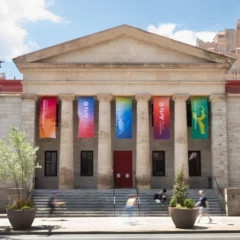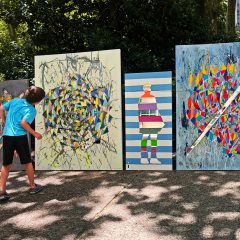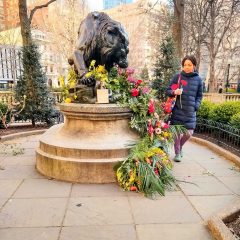Our friend Janet Cooke has been collecting annunciation art postcards since who knows when. Probably it started, says the artist and art educator, when she was living in Europe with her husband, and her mom came to visit. While Janet and mom toured the churches of Europe and looked at the church art, Jim, Janet’s husband — whose tolerance for church art was slim — was enlisted in the quest for postcard Mary’s, Annunciation Mary’s, in the churches’ giftshops. The Marys are easy to love, Janet says–they’re sweet. Janet always intended to do something with the hundreds of postcards she brought back from Europe. Somewhere along the line, just a few years ago, she got it — she appropriated the Marys from their source paintings and painted them on individual 4×6″ canvas boards, isolated in Andy-Warhol-flat backgrounds in gorgeous hues.
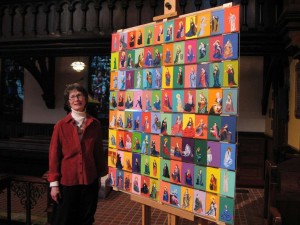
The resulting paintings show Mary as a fashionista, a woman who one moment is draped in voluminous folds, in another wearing something clingy, in still another dressed as a desert maiden. The paintings range in date from Giotto and Boticelli to almost contemporary (Henry Ossawa Tanner, Raphael Soyer). The story portrayed in the source paintings shows Mary reacting to the news she’s just received via angel messaging system. Mary looks up, or she looks down. She clasps her hands to her bosom or she holds them out beseechingly, all according to the traditional conventions to depict the annunciation. Janet has the Mary’s — 96 of them from 96 source paintings — arranged by gesture, so there’s a group of bosom-claspting Marys and a group of beseeching Marys, a bunch of praying Mary’s and even some recoiling Marys.
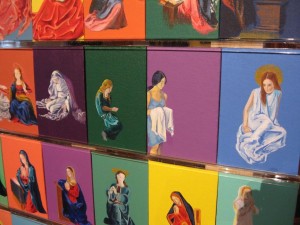
We visited the Marys and Janet last week at the Church of the Holy Trinity on Rittenhouse Square. They were there for just three days, one of them, Friday, Mar. 25, the Feast of the Annunciation. The images were arranged chock a block to form a square (Cooke said she wanted to make 100, but then realized she could not arrange 100 to form a square, but 96 worked).
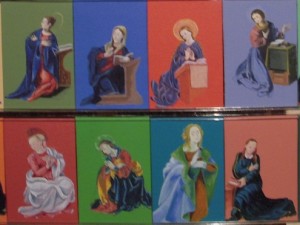
We asked a few questions. Why paint them 4×6″? Because she was working in her living room and because they’re postcard sized. How long did they take to paint? Two to three hours each — acrylic paint. Is this all her postcards or are there more? It’s not all her postcards. What were her favorite Marys? She loves the Raphael Soyer.
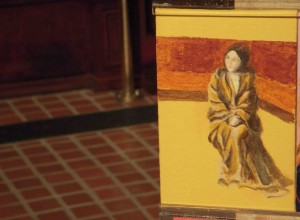
And then because Janet is a long-time Philadelphia Museum of Art staffer in the education department and because she knows a lot of art history, she told us that James Tissot, the French painter, lived in Paris at the same time as Henry Ossawa Tanner. Both of them painted the annunciation and both of them painted Mary as vernacular, Hebrew, women in settings that suggested Middle Eastern rooms. Both artists had traveled to the Middle East and…here’s where Janet makes a big art historical speculation, maybe, just maybe, they both knew each other.
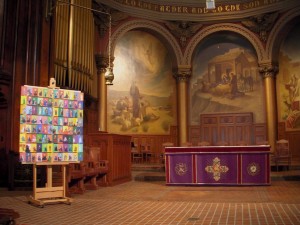
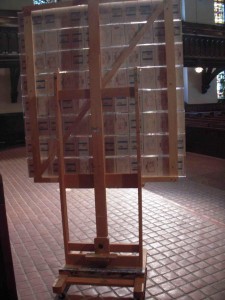
How many annunciation paintings are there in the world anyway? Thousands! Jim has got a database on the computer with more than 5,000 annunciation images. People are still painting annunciations–Brice Marden, Gerhard Richter…Really? Really–she showed us images in a book of annunciation paintings she had on the display table.
Also on display was a 3-ring binder with Janet’s postcards so you could compare her work with the original. And there was information on the Catholic Church dictates on Mary’s traditional hand gestures and what they symbolize.
The work cut both ways–it seemed reverent and irreverent all at once. Somehow, the little cards humanized a figure that is usually too holy to touch–and then took her down her down one notch further, turning her into a paper doll.
We especially liked Dante Gabriel Rossetti’s Pre-Raphaelite Mary, who looks like a character in the Twilight series. Mostly, we thought how great it would be to see this outside a church setting, where religion didn’t cast such a heavy hand of interpretation.


